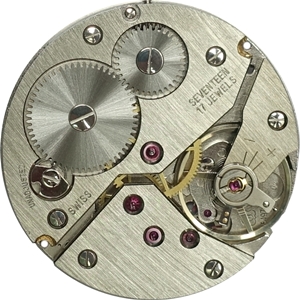Chapters
0:00 Intro
0:44 Crown
1:36 Mainspring
2:14 Wheel Train
2:57 Jewel Bearings
3:11 Motion Works
4:10 Escapement & Balance Wheel
6:38 Supporting Structure
___________________________________________________________________
https://youtu.be/9_QsCLYs2mY?si=BUnZdaALNo5s4Y8y
___________________________________________________________________
This is a Unitas 6497 handwind movement.
This movement was originally designed for pocket watches so it’s quite big.
It only fits into big watches (at least 43mm in diametre).
That also means it’s one of the easiest to take apart and study since the components are also proportionally big.
It’s also one of the simplist in terms of complications.
Most watches nowadays have at least a winding rotor (an asymmetrical weighted rotor that winds the watch using the momentum of your wrist movement) and a date function (an additional 24-hour counter with 31 clicks per rotation).
Not to mention some of the more complex functions like chronograph (stopwatch), minute repeater (chimes the precise time to the minute) and tourbillon (a revolving escapement) etc.
Some more complicated watches can easily have 3 to 5 times more parts than the watch shown in this video.
Now imagine doing all those purely mechanically within the space of a wrist watch.
Then imagine these technologies existing 200 years ago.
______________________________________________________________________
Swiss precision movement
Long Lugs/Historic Radium watches
ETA/UNITAS 6497-1
The ETA/Unitas caliber 6497-1 is a Swiss made mechanical manual wind movement with 17 jewels. This caliber is one of the most popular hand-wound mechanical movements in the watch industry. The 6497 is often referred to as a “pocket watch movement” because that is the origin of the design.
______________________________________________________________________
Unitas 6497: 18,000 bph, Lépine (open face) movement, pallet fork cock.
Lépine watch (Open-face)
In a pocket watch, a structure in which the seconds hand is positioned in line with the winding stem, as opposed to the hunter calibre in which the seconds hand is at a right angle to the winding stem, at 6 and 3 o’clock respectively.
https://watch-movements-archive.com/watch-movement/unitas-6497/
______________________________________________________________________


______________________________________________________________
Captain Convey Pocket Watch Comment
Crown, Mainspring, Wheel Train, Jewel Bearings
Motion Works, Escapement & Balance Wheel
Supporting Structure
The above video shows you how a basic pocket watch functions.
It is based on Unitas 6497: 18,000 bph, Lépine (open face) movement, pallet fork cock.
This video is exactly what I wanted to find and archive on my blog.
It explains how a pocket watch movment functions.
This is how an antique mechanical pocket watch functions.
Learning how to repair an antique pocket watch is much more
detailed information.
My goal is to just understand how an antique pocket watch functions.
Repairing one is not my goal although I plan to watch some videos
on how to do so.
I have watched a few that were very interesting and complicated.
From watching those I can understand why it must be done by
someone with the know how and correct equipment.
The correct equipment can be original or newer.
From what I have seen, to repair an antique pocket watch correctly
it should be original type of repair equipment which is costly.
Understanding what the Crown, Mainspring, Wheel Train, Jewel Bearings
Motion Works, Escapement & Balance Wheel Supporting Structure
functions are is essential.
The above video explains what you need to know first.
The videos on the Watch Odyssey goes into how antique watches
are repaired.
This is exactly what I wanted to know about antique pocket watches.
Why?
Watchmaking is the perfect balance of 50% knowledge and 50%
skill.
50% of watchmaking is understanding the horological basics of
a Watch Movement.
This is enough for me.
I don’t actually need to repair antique pocket watches.
I just want to know how they function and also information
about their maintenance.
Also I don’t plan to pay any money to learn this information
because as you can see, it can be found for free.
The link below to Watch Odyssey will reveal why.
This channel is paced and well done.
The person repairing the antique pocket watches reminds me of a
golf commentator lowering his voice as he describes what is
happening.
This is why I really like Watch Odyssey Youtube Channel.
Its presented in a way you can learn without having to wonder
what was said or done.
https://www.youtube.com/@watchodyssey4894
Watch Odyssey is a journey through time. We track down and restore vintage timepieces long lost to dusty drawers, an old shoebox in the attic, perhaps at the back of a musty cupboard. Often these are family heirlooms with a story to share. Our mission is to investigate the faults and, using vintage watchmaker tools, see if we can bring these magical marvels back to life.
Watch Odyssey is for entertainment and relaxation purposes only. Caution – amateur watchmaker at work.
____________________________________________________________
In 1892, Waltham made a bold claim for it’s Vanguard Railroad Grade Pocket Watch, “The finest 18-Size movement in the World”. Perhaps, with it’s stunning damaskeening, gold settings, rubies and diamonds! This one needs a vintage watchmaker’s lathe to make it right (any excuse). Join us on the restoration journey of this very fine American railroad grade pocket watch.
https://www.youtube.com/watch?v=62nSG65f_TQ
___________________________________________________________________
Find Information about watch movements.